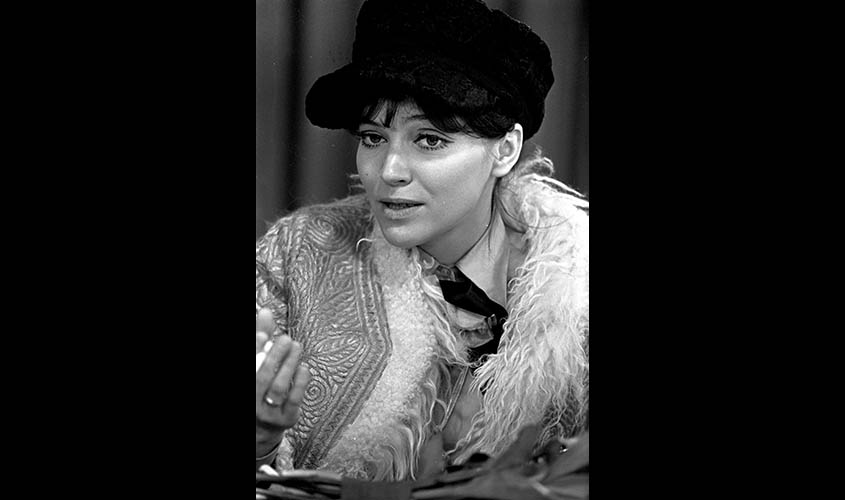Anna Karina, the Danish-born actress who became a symbol of the French New Wave in Jean-Luc Godard’s 1960s films, died Saturday in Paris. She was 79.
The death was confirmed by France’s culture minister, Franck Riester, in a post on Twitter and by her agent, Laurent Balandras, who said the cause was cancer.
Making her first film in her teens, Karina started at the top: Godard’s Le Petit Soldat (The Little Soldier), about terrorism during the French-Algerian War. The film, shot in 1960, was not released until 1963 because of censorship. Between those two events, Karina won the 1961 best actress award at the Berlin International Film Festival for Godard’s Une Femme Est Une Femme (A Woman Is a Woman), in which she played an unmarried stripper who wants to have a baby.
Her other full-length Godard films, released between 1961 and 1966, were Vivre Sa Vie (My Life to Live), about a young woman who drifts into prostitution; Bande à Part (Band of Outsiders), a crime comedy about a romantic triangle and a burglary; Pierrot le Fou, a crime drama about a bored husband on the run with his former mistress, an arms smuggler; Alphaville, a science-fiction tale set in a loveless dystopian future; and Made in U.S.A., a crime comedy set in Atlantic-Cité, a fictional French town.
In later years, Karina played down the notion that she and Godard—whom she married in 1961—were reinventing cinema, as some film historians liked to say, but she did acknowledge his unusual directorial style.
“In older Hollywood movies, a character will make an entrance, close a door, light a cigarette, sit down, have a drink,” she told The New York Times in 2016. “In Jean-Luc’s movies, you were doing everything at once. And sometimes you wouldn’t shut the door all the way. Sometimes your cigarette wouldn’t light on the first try.” It was, she recalled, “more like being than acting.”
Whether playing a streetwalker or a terrorist, Karina managed to look a bit like a schoolgirl, with her dark hair, wispy bangs, heavy eyeliner and lycée-chic wardrobe of sailor-uniform tops, knee socks, lots of plaid and perky headwear, from berets to boaters.
She went on to make about three dozen other films, and took up directing with the 1973 film Vivre Ensemble.“I wanted to see if I could do it. That’s all,” she told The Guardian decades later. She also directed, wrote and starred in her last film, Victoria (2008), about a woman with amnesia traveling in Canada.
Karina also pursued a singing career, with late-1960s hits like Sous le Soleil Exactement and Roller Girl, both written by Serge Gainsbourg. And she wrote four novels, including Golden City (1983), which she described to the quarterly Film Comment as “a kind of thriller, with gangsters.”
But she was still best known for her earliest film roles.
“Whatever Godard required, Karina provided,” a 2016 article in The Guardian said. “She could be headstrong and wayward, gorgeous and broken. She was the effervescent free spirit of the French New Wave, with all of the scars that the position entails.”
Hanne Karin Bayer was born Sept. 22, 1940, in Solbjerg, Denmark, a suburban town on the country’s east coast. Her father left the family a year after her birth. Her mother ran a dress shop.
Hanne lived with her maternal grandparents for three years and was in foster care for four years but eventually went back to live with her mother.
She dropped out of school at 14, sang in cabarets and worked as a television model. At 17, she ran away from home—hitchhiking to Paris—and was discovered by the casting director of an advertising agency while sitting at Les Deux Magots, the fashionable Left Bank cafe. During a photo shoot for Elle magazine, she met fashion designer Coco Chanel, who advised her to change her name.
Godard, a film critic at the time, saw her in a movie theater ad for a Palmolive bath product. When he subsequently offered her a small part in his first full-length film, Breathless (1960), she objected to doing a nude scene. Godard said he didn’t understand—after all, he had just seen her onscreen in a bathtub, looking very comfortable and showing plenty of skin.
“I wasn’t nude,” she told him, according to a 2016 interview with Vogue magazine. “That was your imagination.” She had been wearing a swimsuit in the tub, she said, and “the soapsuds were up to my neck.”
Godard called again and cast her in his next film, Le Petit Soldat. Because she was a minor at the time, she had to seek permission from her estranged mother, who flew to Paris to sign the contract.
Information on survivors was not immediately available.
Karina had little connection with American movies. She had a role in George Cukor’s Justine (1969), but that movie had an international cast, including Anouk Aimée and Dirk Bogarde. She also made an appearance in Jonathan Demme’s “The Truth About Charlie” (2002), but it was filmed mostly in France.
After her divorce from Godard (“He would say he was going out for cigarettes and come back three weeks later,” she told The Guardian), she married several other times. Her second and third husbands, Pierre Fabre and Daniel Duval, were actors, and both marriages ended in divorce. She married American-born film director Dennis Berry in 1982.
Karina was happy to acknowledge Godard as a Pygmalion figure but also pointed out her own contributions. As she told a French video interviewer in the 1960s, “I gave him self-confidence.”
© 2019 The New York Times

